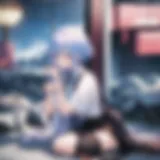Exploring Goblin Slayer Season Two: Insights and Expectations
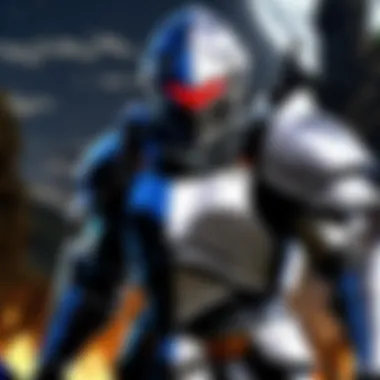

Prelude to the Series
Goblin Slayer, based on the dark fantasy light novel series written by Kumo Kagyu and illustrated by Noboru Kannatsuki, has carved a unique niche within the anime culture since its initial airing in 2018. The anime marries adventure with elements of horror, presenting a vivid backdrop where adventurers face terrifying creatures, particularly goblins. This fusion of genres sets the stage for an intense viewing experience.
Premiered in October 2018, the first season captivated audiences with its gripping narrative and complex characters. Its premise revolves around a lone warrior, known simply as Goblin Slayer, whose singular focus is eliminating goblins. Amidst his bloody pursuit, he encounters a band of adventurers, fostering intriguing group dynamics and character growth.
The reception of the series has sparkled both praise and criticism. Many fans have lauded it for its unapologetic portrayal of violence and its raw examination of trauma, while some have raised eyebrows at the graphic content depicted in various episodes. Regardless of the divisive opinions, it amassed a significant following, demonstrating the audience's appetite for more adventures in this unforgiving world.
"The series stands as a breath of fresh air for fantasy enthusiasts, diving headfirst into themes often glossed over in more traditional narratives."
As we look forward to Season Two, it becomes crucial to explore what elements have resonated with viewers and what potential developments may emerge as we re-enter this grim universe.
Prologue to Goblin Slayer
The Goblin Slayer series holds a unique position within the realm of anime, capturing the attention of viewers since its initial release. To embark on a journey into its second season, it is vital to understand the foundational aspects that define the series. This introduction serves as a springboard for exploring the intricate web of themes, character arcs, and production insights that await in the new season. By delving into the fundamental elements of Goblin Slayer, both new and returning viewers can appreciate the depth of storytelling and character motivations at play.
Overview of the Series
Goblin Slayer is set in a fantasy world where adventurers battle various creatures, but the central focus is on goblins and the titular character's relentless quest to eradicate them. At its heart, the narrative confronts darker themes, illustrating not just battles but the traumas experienced by those who face these creatures. The series does not shy away from the visceral fear and violence associated with its subject matter.
The protagonist, known simply as Goblin Slayer, is an absurdly serious man on a singular mission driven by a tragic backstory. His encounters and interactions with characters such as Priestess and others shape a world rich in lore and complexity. Each episode intricately weaves together action, drama, and moments of character development.
Audiences are drawn to the visual and narrative elements that define the series — its compelling character designs, intense combat sequences, and the underlying sense of peril that lingers with each scene. What sets Goblin Slayer apart from other fantasy anime is the unflinching approach to its darker elements, creating an immersive experience that stimulates discussion about morality and the darkness present in the human psyche.
Key Themes in Goblin Slayer
The exploration of Goblin Slayer reveals several core themes that resonate throughout the series, touching on subjects that aren’t often addressed head-on in the fantasy genre. One significant theme is trauma and resilience. Characters grapple with their pasts, often revealing profound scars left by their experiences. This raw exploration gives viewers a deeper understanding of what drives each character’s actions and decisions.
Another key theme is the idea of survival and vigilantism. Goblin Slayer epitomizes this pursuit in his singular quest for justice, albeit in a morally ambiguous fashion. He operates within a grey area, where traditional notions of heroism are challenged. The series also delves into camaraderie; while motivated by personal vendettas, each character learns the importance of friendship and support in the face of adversity.
Furthermore, the portrayal of goblins serves as an examination of societal perceptions of evil. The series encourages viewers to question what constitutes a monster and whether innate traits dictate one’s actions. This complexity elevates Goblin Slayer beyond mere blood and gore; it prompts philosophical reflections on heroism, morality, and redemption.
"In Goblin Slayer, the myth of the monstrous evil is reexamined, leading to profound realizations about intent and nature."
As anticipation builds for Season Two, reflecting on these themes forms the backdrop against which new narratives will unfold. Understanding the essence of the previous season lays the groundwork for viewers to better appreciate the developments ahead. Expecting deeper character revelations and thematic expansions will undoubtedly enhance the viewing experience.
Characters in Focus
Examining the characters in Goblin Slayer is crucial for a deeper understanding of the narrative. Each character contributes unique perspectives and brings layers to the story, enhancing the emotional and thematic complexity. Characters can also represent various aspects of fantasy tropes, allowing viewers to engage with familiar archetypes reimagined in the harsh world of goblin hunting. These explorations are not just for character development; they enable audiences to reflect on broader themes of humanity, morality, and courage.
Goblin Slayer: A Character Analysis
Goblin Slayer is far more than just the title character; he embodies the driving force of the series. His singular focus on hunting goblins stems from a traumatic past—witnessing the death of his village and the horror inflicted by these creatures. This backstory shapes his persona, making him relentless and often anti-social.
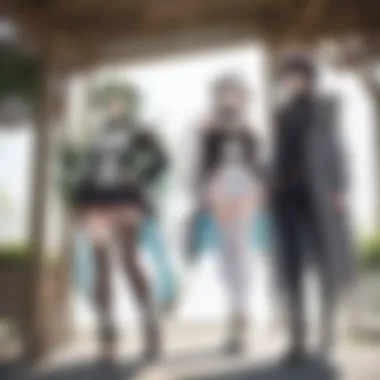

His stoic demeanor hides an emotional depth, often revealing itself in moments of vulnerability. When he interacts with others, viewers get a glimpse of a man shaped by loss, constantly teetering between his quest for revenge and his capacity for connection. His method of problem-solving is notably brutal, steeped in practicality rather than heroism. This makes him both an anti-hero and a relatable figure. He may not always be likable, but his pain and purpose resonate deeply.
In this way, Goblin Slayer serves as a lens through which the audience can explore themes like trauma and the cost of vengeance. His moral ambiguity invites discussions among fans about what constitutes a hero in dark fantasy settings.
Supporting Characters and Their Arcs
The supporting cast of Goblin Slayer plays pivotal roles that amplify the main storyline while also providing a variety of perspectives. Each character carries their own emotional baggage, which creates a rich backdrop against Goblin Slayer's cold ruthlessness.
For instance, Priestess showcases gentleness and determination, often acting as the moral compass for the group. Her growth from an inexperienced novice to a confident adventurer mirrors the show's thematic evolution.
Meanwhile, characters like the Mage and the Warrior introduce insights into different combat styles, showcasing how teamwork enhances effectiveness even against formidable foes. Their interactions spark camaraderie, showcasing what lies beyond the battles—friendship, trust, and shared objectives. This dynamic allows for light moments, juxtaposed against the series’ darker themes, making the storytelling well-rounded.
Additionally, the introduction of new characters in Season Two is highly anticipated. Fans can expect fresh narratives and perhaps unexpected alliances, deepening existing arcs or even leading to conflicts that challenge character motives.
Antagonistic Forces in the Narrative
While Goblin Slayer faces countless goblins, the antagonistic forces extend beyond mere creatures. The real antagonism often comes from the moral dilemmas and catastrophic events surrounding them. Each goblin is a manifestation of fear, chaos, and the darker sides of humanity. They represent not only a physical threat but also embody deeper societal issues such as trauma and loss.
In addition to the physicality of the goblins, other antagonistic forces include societal structures and the characters' internal struggles. How society views Goblin Slayer himself—sometimes as a fanatic—adds layers of conflict. Understanding how different characters react to this fanaticism provides a lens through which to examine societal norms and personal beliefs. Thus, while the enemies may wear a physical form, it is often the struggles within and between characters that intensify the tension in the narrative.
In synopsis, Goblin Slayer transcends simple character battles; it delves into the complex web of relationships and societal challenges, making each arc pivotal to the overall story. As we anticipate Season Two, its emphasis on character interactions and their respective growth remains a critical aspect to watch.
Production Insights
Understanding the production behind a successful anime series like Goblin Slayer is crucial for fans and newcomers alike. The production elements shape the viewing experience, influencing everything from character portrayal to the overall atmosphere. As we anticipate the second season, reflecting on how the animation studio, key production staff, and sound design contribute provides insight into what enhances or possibly detracts from the narrative. More importantly, these facets collectively help us to appreciate the artistry and effort that go into bringing intricate stories to life.
The Animation Studio Behind Goblin Slayer
The animation studio that brought Goblin Slayer to life is White Fox, a well-regarded name in the anime industry. Known for their meticulous attention to detail, White Fox has a reputation for enhancing source materials through high-quality animation. Their approach to Goblin Slayer showcases impressive fluid motion during action sequences, drawing viewers into intense battles as if they are part of the chaos. This showcases how animation can amplify tension and emotion.
With vibrant colors and detailed backgrounds, the studio effectively creates a world that feels both familiar and fantastical. Importantly, by sticking closely to the manga's visual style, White Fox bridges the gap between different storytelling mediums. This adherence not only respects the original work but also has a hand in capturing the darker themes of the series. The differences in how the studio interprets action or mood can often determine how the audience perceives vital story elements. It’s no surprise that a well-thought-out animation direction can make or break a series.
Key Production Staff and Their Contributions
A significant factor in the series' success lies in its talented production staff. Each individual plays a unique role, creating a tapestry of skills that result in a polished outcome. Here are a few crucial contributors:
- Yamakan Yuuichirou: The director has a vision that shapes the narrative significantly. His ability to balance dark themes while maintaining engaging character moments speaks to his storytelling prowess.
- Saito Masahiro: As the series composer, Saito knits together the plot threads with a careful eye for pacing and tension.
- Abe Takahiko: The head of character design, ensuring that character appearances reflect their personalities and arcs effectively.
Each of these roles is essential. Their combined efforts create a cohesive anime that resonates with viewers, effectively defining what makes Goblin Slayer unique. The lore of the original material is respected while still finding room for originality. This collaboration of talent helps maintain consistency in animation quality and character development, ultimately enriching the audience's experience.
Music and Sound Design: Setting the Mood
Music and sound design are often unsung heroes in any production. In Goblin Slayer, the sound design meticulously accentuates tension and engages audience emotions. The score, composed by Masaru Yokoyama, carries a weight that complements the dark undertones of the series. It’s more than just background noise; it dialogues with the audience and heightens moments of suspense.
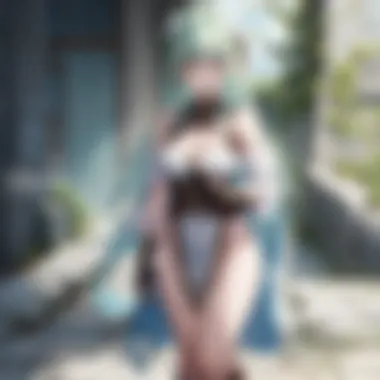

From eerie soundscapes to adrenaline-pumping background music during battles, every note builds an atmosphere that draws the viewer in. The sound effects also play a vital role—each clash of swords, and the subtle whispers in dark settings help to make the world feel alive and real. The use of ambient sounds transports the audience into the depths of dungeons or through tranquil forests, creating an immersive experience.
In summary, production insights are the bedrock of understanding what makes Goblin Slayer remarkable. From the animation studio's vision to the skills of production staff and the intricacies of sound design, every aspect contributes to the overall experience. These components serve as a framework that not only showcases the artistry involved in anime creation but also prepares fans for what to expect in the upcoming season.
Plot Expectations for Season Two
Understanding the upcoming narrative for Goblin Slayer's second season is crucial because it not only shapes viewers' anticipation but also sets the stage for character growth and thematic resonance. This anime has gained a reputation for its grim yet captivating storytelling, and expectations are understandably high. Fans are keen to see how the complex narrative threads will weave together, how characters evolve, and what new conflicts await them on this perilous adventure.
The anticipation is layered; fans not only want action and adventure but also depth and substance in the plot. How the creators choose to adapt key elements from the source material can affect the overall impact of the story they present. Every detail, from the pacing to the dialogue, carries weight in creating a coherent experience that satisfies both new viewers and seasoned fans.
Continuing the Journey: What Lies Ahead
As season two unfolds, the central question lingers: where will Goblin Slayer and his party head next? Following the first season's conclusion, the narrative opens up to a world filled with potential encounters and conflicts. The diverse landscapes and cultures within the anime’s setting offer a myriad of opportunities for exploration. The introduction of new allies and foes can expand the scope of the story, creating a tapestry full of tension and intrigue.
The emotional threads established in season one are likely to deepen. We can expect more character backstories to surface, which could flesh out motivations and relationships within the party. Perhaps the viewer will catch glimpses of the Goblin Slayer's past, shedding light on why he became so devoted to his mission.
New challenges may arise, potentially forcing the characters to confront not only external threats but also their internal conflicts. Mythical creatures and unforeseen dangers could test their bonds and convictions. Fans should brace for unexpected twists along the way, which have become a hallmark of Goblin Slayer.
Speculations Based on Source Material
Diving into the source material gives us a clearer roadmap of what might come in the next season. The light novels provide a rich narrative foundation that the anime can draw from, showcasing various arcs and conflicts yet to be animated. The careful selection of content from these writings will dictate the emotional and thematic depth that viewers can expect.
For instance, certain arcs introduce fresh characters that might significantly alter the dynamics of the existing group. Adaptations may include elements like the Church of Law, which introduces different philosophies on goblin hunting, potentially clashing with Goblin Slayer’s singular focus on extermination. Such contrasting ideologies can provoke rich discussions and moral dilemmas among the characters and the audience alike.
Further, there are hints of increasing complexity in battles that could have fans on the edge of their seats. Adaptation of specific fight scenes from the novels would not only showcase the animation studio's capabilities but also highlight strategic growth amongst the characters. This is significant as it reinforces the theme that combat isn't always brute strength but also wits and strategy.
In summary, the expectations for Goblin Slayer’s second season remain high. The blend of dramatic character evolution, rich world-building and gripping narrative developments makes it an exciting prospect for both the fans and the uninitiated. The balance between expected developments and unforeseen twists creates a pull that is hard to resist.
Reception and Impact of Season One
The reception and impact of Season One of Goblin Slayer cannot be understated, as it set the groundwork for both critical discourse and audience expectations surrounding the series. The anime not only generated a considerable amount of buzz but also ignited varied conversations about its thematic choices and character portrayals. Understanding this context is vital for viewers looking forward to Season Two. It highlights how the anime has resonated with diverse audiences and influenced the fantasy genre as a whole.
Critical Reception and Audience Responses
Goblin Slayer initially met with a mixed bag of critical reviews, which played a crucial role in shaping public perception. Some praised its gritty narrative and character development, appreciating how it tackled darker themes often shunned by mainstream fantasy anime. On sites like Reddit, discussions flourished, with viewers passionately dissecting elements like the depiction of goblins as a legitimate threat, in stark contrast to many other series that might gloss over such aspects.
The animation quality by White Fox was also noted, elevating action scenes into visually striking sequences that fans found engaging. While initial reactions from critics were divided — some lauding bravery in its storytelling, while others criticized potential insensitivity in its portrayal of violence — the audience responses leaned towards the positive. Viewers found its blend of traditional fantasy tropes with distinct, mature themes refreshing.
The show garnered a dedicated fanbase, prompting extensive social media engagement. Posts on platforms like Facebook and fan art showcasing beloved characters flooded online spaces as the community rallied for its continuation.
Key takeaways from this reception include:
- Diverse Audience Engagement: The anime resonated with a broad spectrum of viewers.
- Thematic Depth: Its mature themes prompted thoughtful discourse around fantasy narratives.
- Artistic Quality: Recognition of high-quality animation enhanced viewer experience.
- Controversial Aspects: The show ignited debates about appropriate content in anime.
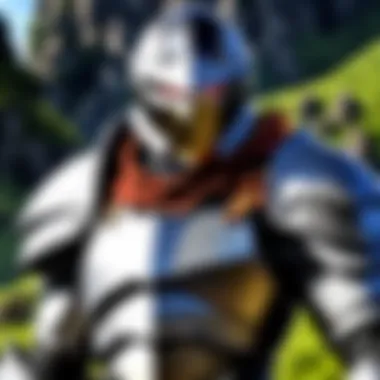

"Goblin Slayer shook the foundations of fantasy anime and challenged boundaries that many were hesitant to explore.*"
Cultural Impact on the Fantasy Genre
The impact of Goblin Slayer on the wider fantasy genre is another noteworthy consideration. By weaving in darker narratives and disillusioned hero tropes, it has helped carve a niche for more serious storytelling within the usually lighthearted fantasy realm. Its popularity has prompted other series to consider similar approaches, blending humor and drama in a way that reflects more complex human experiences.
As it found its footing, Goblin Slayer influenced both creators and fans alike. Newer shows are now experimenting with a range of themes, tackling issues such as trauma, moral ambiguity, and existential threats; something uncommon in traditional fantasy narratives up until this point.
Another critical aspect is the rise of discussions regarding gender roles in fantasy anime, as Goblin Slayer showcased female characters who were neither mere sidekicks nor damsels in distress. They were warriors and developed characters in their right. This evolution in character portrayal has inspired different story arcs in emerging series.
In summary:
- Genre Evolution: Shifting towards darker themes influenced by Goblin Slayer.
- Character Development: Encouraging strong, multi-dimensional female roles in anime.
- Narrative Complexity: A push for more serious storytelling in the fantasy genre.
Overall, as we anticipate Goblin Slayer Season Two, it's essential to recognize how Season One's reception not only shaped audience expectations but also left a profound mark on contemporary anime culture, setting the stage for continued exploration of mature themes.
Comparison to Other Fantasy Anime
The realm of fantasy anime is vast and varied, filled with numerous narratives that capture the imagination of audiences. When examing Goblin Slayer, one cannot help but draw parallels with other titles that share similar thematic elements or narrative structures. This comparison is essential for viewers to appreciate what Goblin Slayer brings to the table while understanding its unique position in this animated landscape.
Similarities and Differences with Peers
In the ever-expanding genre of fantasy anime, Goblin Slayer finds itself resonating with various motifs and themes prevalent in its contemporaries. Titles like Berserk and Re:Zero explore dark narratives with intricate world-building and complex characters. However, Goblin Slayer distinguishes itself in a few notable areas:
- Focus on a Single Foe: Unlike many series where the protagonist battles grand, overarching threats, Goblin Slayer sticks closely to its namesake. This concentrated approach amplifies the stakes, turning each goblin encounter into a matter of life and death.
- Realism in Violence: Compared to Sword Art Online, which balances intense battles with moments of light-heartedness, Goblin Slayer embraces a more brutal reality. The violence isn't just for show; it serves as a reflective commentary on trauma and survival.
- Character Development: While series such as That Time I Got Reincarnated as a Slime delve into character evolution and friendships, Goblin Slayer particularly focuses on the psyche of its titular character. His journey is shaped less by camaraderie and more by a singular, traumatized mission.
Positioning in the Anime Landscape
What sets Goblin Slayer apart isn’t just its narrative strategy; it’s also its unique position within the anime landscape.
- Subverting Tropes: Traditional fantasy often idealizes heroes and quests, but Goblin Slayer pulls the curtain back on the grim realities of heroism. It paints a world where heroes face much darker obstacles and moral dilemmas.
- Audience Engagement: The anime doesn’t shy away from heavy themes, which can leave viewers feeling unsettled yet provoked to think critically. This approach can foster deep discussions among fans about morality and the concept of heroism in the fantasy genre.
- Cultural Commentary: By integrating darker elements, Goblin Slayer provides viewers with an avenue to explore societal issues wrapped in a narrative about goblins and slayers. It invokes a response that leads to reflection, questioning societal norms surrounding fantasy narrative arcs.
Analyzing Goblin Slayer in relation to its peers offers insights into its innovative storytelling and themes. By highlighting its similarities and stark differences, fans gain a more nuanced understanding of what makes this series stand out in a crowded field. In this sense, Goblin Slayer is not just another fantasy tale but rather a profound narrative that challenges and engages its audience at every turn.
End
As we look forward to Goblin Slayer Season Two, it becomes crucial to reflect on what this anticipated installment means for both the series and its fanbase. The conclusion of this article provides a platform to distill the multifaceted elements examined throughout the discussions.
Key Elements to Consider
- Character Arcs: The evolution of characters, such as Goblin Slayer himself and the dynamics with supporting roles, will be vital to the narrative. Viewers will be keen to see how these relationships mature and intertwine with threats that loom larger.
- Thematic Depth: The series has always explored darker themes, from the harsh realities of adventuring to the psychological impacts on its characters. The second season is likely to delve deeper into these narratives, offering a rich tapestry for reflection.
- Production Quality: With insights into the animation studio and production team, expectations are high for visual storytelling that is on par with the first season, if not exceeding it. The synergy between animation, sound design, and narrative pacing will play a crucial role.
- Fan Engagement: The community surrounding Goblin Slayer has grown, and their anticipation reflects the success of the first season. The reactions and theories swirling in online platforms provide a unique symbiotic relationship between creators and viewers, enhancing the overall experience of consuming the anime.
Benefits of Understanding Anticipation
Anticipating Goblin Slayer Season Two enriches not only the viewing experience but fosters a sense of community among fans. By understanding the key themes and character developments, audiences position themselves for a more profound engagement with the story. Recognizing the artistic choices made by the creators can bolster appreciation, transforming passive viewing into an active discourse.
"Engaging with a series like Goblin Slayer isn't just about watching; it's about immersing yourself in a world layered with challenges, growth, and enchantment."
In summary, the excitement for the second season isn't merely about wanting to see what happens next. It's about the journey of the characters, the echoing themes of perseverance, and the meticulous craftsmanship that brings this world to life. As we stand on the brink of a new chapter, the insights gained through the examination of past elements coupled with expectations for the future create a palpable tension, laying the groundwork for what promises to be another compelling season.
